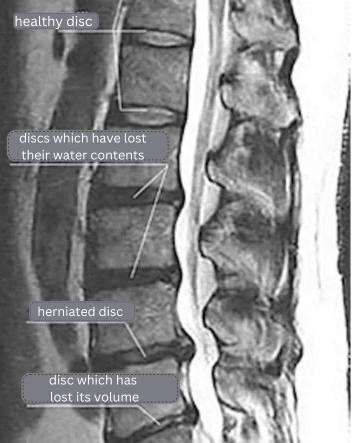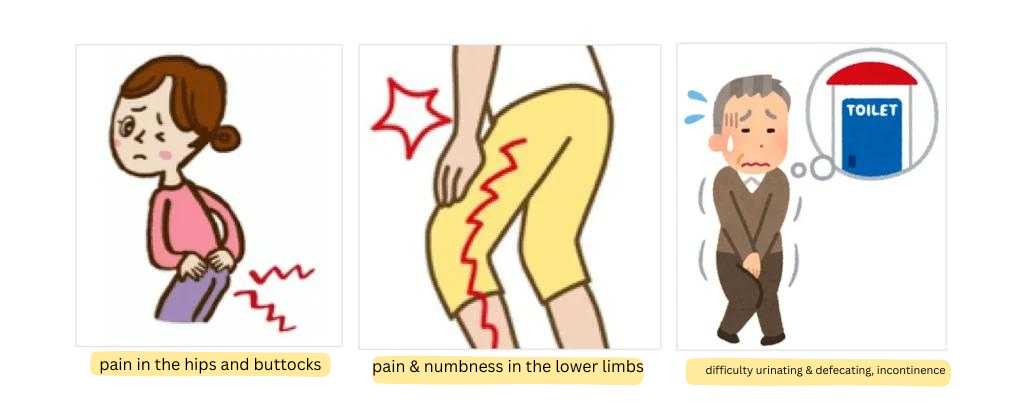Column What is Lumbar Disc Herniation? Causes of Pain and Symptoms
July 5, 2023
Lumbar disc herniation is the most prevalent spinal disease in the world, but what exactly is this medical condition?
What is a lumbar disc herniation?
Intervertebral discs are located between the vertebrae. Each disc is composed of a gelatin-like nucleus pulposus in the center and a collagen-rich annulus fibrosus enclosing it. The intervertebral disc is formed by those two tissues, the nucleus pulposus and the annulus fibrosus.
When the nucleus pulposus starts protruding outward due to a fissure in the annulus fibrosus, this is called a herniated disc. A herniated disc situated in the lumbar region is called a lumbar disc herniation.
The main causes of disc herniation are the senescence of the disc caused by genetic factors, and aging incurred through the strain of daily activities. Together with aging and the strain of daily life, cracks in the annulus fibrosus of the disc cause the nucleus pulposus to leak out of the annulus fibrosus and lose water, resulting in a flattened disc that has lost its volume. Lifting heavy objects in daily activities or engaging in strenuous sports in particular can lead to disc damage.
An x-ray or MRI will show a black disc, confirming the loss of volume.

Symptoms of Lumbar Disc Herniation
Apart from back pain, the main symptoms of a herniated lumbar disc are pain and numbness in the buttocks and legs. Pain and numbness can occur anywhere in the lower body, but pain from the buttocks to the back of the thighs, especially sciatica, is a common symptom of a herniated lower back.
The spine then begins to curve sideways, making motions more difficult, and the pain may intensify when lifting heavy objects. Symptoms may appear suddenly or more gradually.
If the nerve compression is very severe, it may cause difficulty in passing urine or stool, or even provoke involuntary urination.

The causes of pain
For a long time, it has been an enigma as to why some severe hernias are painless, while some mild hernias may cause severe pain. Recently, it has been discovered that pain is caused by the inflammation of the protruding nucleus pulposus, which in turn sparks inflammation in the surrounding nerves.
It has also been found that the inflammation of the protruding nucleus pulposus spontaneously disappears after a certain time (usually several months). It is comparable to a bonfire, which burns very intensely when a new piece of wood is added to it, but eventually dies out after a certain period. And just as firewood remains as charcoal after burning, hernias can remain after the inflammation. This residual herniation appears on imaging studies as a severe herniation but has no symptoms because the inflammation has subsided.
The pain from a herniated disc is not caused by physical nerve compression from the protruding nucleus pulposus, but by its inflammation.
For patients experiencing persistent pain for more than a few months, this means that a different nucleus pulposus has been constantly leaking. Conversely, a person whose pain has improved means that the nucleus pulposus has stopped leaking.
This is very important to understand the condition of a herniated disc. Surgical procedures may remove the leaking nucleus pulposus and eliminate the inflammation, but they are unable to seal the cracks in the annulus fibrosus, so the nucleus pulposus continues leaking and herniate again, causing pain and other symptoms to resurface eventually.
To effectively cure a lumbar disc herniation and prevent recurrence, it is essential to heal the disc.
Treatment to repair the intervertebral disc – the Cellgel method
The Celgell method is one of the advanced treatment methods that have been researched and developed in recent years and is one of the newest treatment methods that is supported by solid evidence.
It constitutes a curative treatment because it can “heal the intervertebral disc,” which up to now was not possible with other treatment methods. It is characterized by the fact that the volume of the disc is not reduced, and the drug remains in the disc as a gel-like implant after treatment, thus preserving the disc.
It can be applied not only to herniated discs but also to a wide range of other conditions and can also be used for patients who have failed to see any pain relief after undergoing a surgery, or who have had a recurrence of pain, as well as for elderly patients who are over 80 years.

If you have ever been diagnosed with a herniated disc or suffer from back pain, please consider coming to our clinic for a consultation.
Related Articles
Various Treatments for Lumbar Disc Herniation: Respective Differences and Results of Each Method



